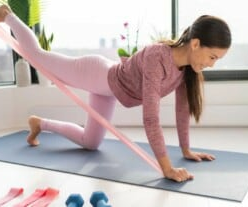
Beginner Exercising: Embarking on a fitness journey can be both exciting and overwhelming for beginners. With a plethora of workout options, diet plans, and advice, it’s crucial to find a clear and manageable starting point. This article aims to guide beginners through the process of starting to exercise, from understanding their fitness goals to creating a workout plan and maintaining motivation. Whether you’re planning to work out at home or in the gym, the following key takeaways will provide a practical framework to help you embark on your fitness regime with confidence.
Key Takeaways
- Identify specific fitness goals to tailor your exercise plan and stay motivated.
- Choose exercises that align with your interests and physical capabilities to ensure consistency.
- Start with a sustainable pace to avoid burnout and gradually increase intensity as you progress.
- Incorporate a mix of strength training and cardio for a balanced workout routine.
- Prioritize nutrition, hydration, and adequate rest for optimal recovery and performance.
Laying the Foundation: Starting Your Exercise Journey

Understanding Your Fitness Goals
Before embarking on your fitness journey, it’s crucial to define clear and attainable goals. Whether your aim is weight loss, muscle gain, or overall health improvement, specific objectives will steer your efforts and maintain your drive. Break down your long-term goals into short-term, manageable milestones to make them more approachable and to celebrate your progress incrementally.
Establishing a solid foundation for your fitness journey begins with a well-defined set of goals. This clarity not only fuels your motivation but also shapes the direction of your workout plan.
Understanding your nutritional needs is also part of setting fitness goals. While some may opt for calorie counting to tailor their diet, others might prefer learning about proper portion sizes. Here’s a simple guide to get you started:
- Determine your daily caloric needs based on your fitness objectives.
- Learn about balanced meal composition.
- Incorporate nutrient-dense foods that support your workout regimen.
Remember to prioritize recovery as it is as crucial as the exercise itself. Adequate sleep, hydration, and stress management are key components that support muscle recovery and overall well-being.
Choosing the Right Exercise for You
When beginning your exercise journey, it’s essential to select activities that align with your personal preferences and fitness level. Finding the right exercise is a crucial step for beginner exercising, as it can greatly influence your consistency and enjoyment. Consider various factors such as the type of activity, intensity, and how it fits into your schedule.
- Type of Activity: Choose something you enjoy, whether it’s walking, swimming, cycling, or yoga.
- Intensity: Start with low to moderate intensity to avoid burnout and injury.
- Schedule: Pick times that are convenient for you, ensuring you can maintain regularity.
Consistency is key in building a fitness habit. Opt for exercises that you can perform regularly and with pleasure, as this will help you stay on track and see progress over time.
Remember to listen to your body and adjust your choices as you become more comfortable with exercising. The goal is to create a sustainable routine that supports your health and well-being without feeling like a chore.
Setting a Sustainable Pace
When embarking on an exercise routine, it’s crucial to set a pace that is not only challenging but also sustainable. Sustainable weight loss and fitness gains are achieved through consistent, manageable efforts over time, not through sporadic and intense bursts that are hard to maintain.
Begin by walking regularly for about 20-30 minutes, three to four times a week. This will help condition your body and prepare it for the impact of running. As you gain strength and endurance, you can gradually introduce running intervals into your walks. Remember, the goal is to exercise at an easy, conversational pace, which you feel you could maintain forever.
To avoid injury and burnout, listen to your body and adjust your pace accordingly. If you’re feeling strong and want a challenge, increase your intensity or duration slightly. Conversely, if you’re struggling, it’s perfectly fine to dial back and repeat any week of your training until you feel ready to progress.
Here’s a simple progression plan to help you transition from walking to running:
- Start with a run/walk ratio of 1:4 minutes.
- Gradually build to a run/walk ratio of 2:4 minutes.
- Aim for a run/walk ratio of 4:2 minutes, then 6:3 minutes as you become more comfortable.
By following these steps and respecting your body’s limits, you’ll be on the path to a healthier lifestyle and long-term success.
Creating Your Workout Plan: A Step-by-Step Guide

Designing a Balanced Routine
A balanced exercise routine is essential for overall fitness and injury prevention. Start with a one-to-one work-to-rest ratio, gradually decreasing rest time as your endurance improves. For beginners, it’s crucial to focus on form over weight to maximize the benefits and minimize the risk of injury.
When constructing your routine, consider the following:
- Include a variety of exercises to work different muscle groups.
- Balance strength training with cardiovascular workouts.
- Allow for rest days to enable muscle recovery and growth.
Consistency is key in any exercise plan. Aim for 2-4 workouts per week, ensuring you have at least 48 hours of rest between sessions targeting the same muscle groups. It’s better to have a shorter, more frequent routine than to overexert yourself in fewer, longer sessions.
Incorporating Strength and Cardio Training
When embarking on a fitness regimen, it’s crucial to include both strength training and cardio to achieve a balanced workout. Strength training builds muscle and enhances metabolic rate, while cardio improves heart health and increases stamina.
To effectively combine these elements, consider the following approach:
- Start with a warm-up to prepare your body for exercise.
- Alternate between strength exercises and cardio bursts to keep your heart rate up.
- Aim for full-body strength workouts that engage all major muscle groups.
- Incorporate various cardio exercises, such as running, cycling, or swimming, to find what you enjoy and can sustain.
By integrating strength training with cardio, you not only work towards a more sculpted physique but also boost your endurance, ensuring a comprehensive fitness journey.
Remember to listen to your body and adjust the intensity of your workouts to match your current fitness level. As you progress, gradually increase the challenge by adding weight, slowing down during the toughest part of an exercise, or incorporating jumps into bodyweight moves.
Adjusting Your Plan as You Progress
As you embark on your fitness journey, it’s crucial to evaluate and adjust your workout plan to align with your evolving capabilities and goals. This iterative process ensures that your routine remains challenging yet achievable as you gain strength and endurance.
- Step #1: Assess your current performance and comfort level with your existing routine. Are you completing your workouts with ease, or do you find certain exercises too demanding?
- Step #2: Modify the intensity, duration, or complexity of your exercises based on your assessment. This could mean increasing weights, extending your workout time, or incorporating more advanced movements.
- Step #3: Revisit your goals regularly. Have your objectives changed? Are you aiming to lose weight, build muscle, or enhance overall fitness? Adjust your plan to stay on track with these targets.
It’s essential to listen to your body and progress at a pace that feels right for you. If a particular week’s routine feels too easy or too challenging, don’t hesitate to modify your schedule accordingly. Remember, consistency over time yields the best results.
Finally, keep a record of your workouts to monitor your progress. This log will serve as a motivational tool and a practical guide for future adjustments.
Home Workouts: Building Strength Without Equipment

Essential Bodyweight Exercises for Beginners
Starting your fitness journey with bodyweight exercises is a smart move. They require no equipment, can be performed anywhere, and are effective for building strength and endurance. Begin with exercises that are manageable and gradually increase the difficulty as you get stronger.
Here’s a simple circuit to get you started:
- 10 Assisted Bodyweight Squats
- 10 Elevated or Knee Push-ups
- 10 Dumbbell rows (use a milk jug or other weight)
- 15-30 Second Knee Planks
- 10 Bodyweight Good Mornings
- 20 Walking Jacks
This circuit is designed to target major muscle groups and improve overall fitness. It’s important to focus on form to prevent injury and maximize the benefits of each exercise.
As you progress, you can introduce more challenging variations, like full push-ups or unassisted squats. Consistency is key, so aim to complete this circuit several times a week, adjusting the number of repetitions and sets to suit your fitness level.
Crafting an Effective Home Workout Circuit
To create an effective home workout circuit, begin by selecting a balanced mix of exercises. Choose six to ten exercises, ensuring coverage of all major muscle groups: upper body, lower body, and core. This variety not only promotes full-body fitness but also keeps the workout engaging.
Organize your circuit to alternate between cardio and strength exercises. Aim for short bursts of high-intensity effort, such as 30 seconds per exercise, with minimal rest in between. This approach helps maintain a high heart rate, offering both strength and cardio benefits.
Circuits are ideal for home workouts as they require minimal equipment and can be easily adapted to any fitness level. They provide movement variety, which is crucial for both physical and mental stimulation.
Remember to include exercises that target different areas:
- Shoulders: Overhead press, lateral raise
- Legs: Squats, lunges
- Glutes: Glute bridge, hip thrust
- Core: Plank, mountain climber
- Cardio: Jumping jacks, high knees
By crafting a circuit that includes a range of movements, you’ll ensure a comprehensive workout that improves overall fitness and keeps you motivated.
Staying Motivated and Consistent
Maintaining motivation and consistency in your home workouts is crucial for long-term success. Start by setting realistic goals and be willing to adjust them as you progress. This flexibility can help keep you from feeling discouraged if you encounter setbacks.
To build a habit, consider working out at the same time each day and create pre-workout rituals, like listening to a specific playlist. These consistent cues can help solidify your exercise routine into your daily life.
Rewarding yourself after achieving small milestones can be a powerful motivator. Celebrate the progress you make, whether it’s through a small treat, a rest day, or simply acknowledging your hard work.
Remember to surround yourself with a supportive community, whether it’s friends, family, or an online group. Having others to share your journey with can provide encouragement and accountability. Lastly, don’t underestimate the importance of recovery; ensure you get adequate sleep and hydration to support your fitness journey.
Gym Training for Beginners: Navigating the Fitness Floor

Familiarizing Yourself with Gym Equipment
When you first step into the gym, the array of equipment can be overwhelming. Start by identifying the basic machines and their functions. Treadmills, stationary bikes, and elliptical trainers are staples for cardiovascular workouts. For strength training, familiarize yourself with dumbbells, barbells, and resistance machines.
It’s important to use equipment correctly to prevent injury and maximize effectiveness. Begin with lighter weights to master the form before progressing. Most machines have instructional diagrams; take time to read them. If unsure, don’t hesitate to ask gym staff for assistance—they’re there to help.
While machines can be useful for beginners, it’s essential to learn proper technique and not rely solely on equipment availability. Adapting to free weights and bodyweight exercises can provide a more versatile workout experience.
Remember to practice gym etiquette: return weights to their racks and wipe down machines after use. This courtesy helps maintain a clean and organized environment for everyone.
Understanding Gym Etiquette
When you step into the gym, it’s not just about your workout; it’s about sharing a space respectfully with others. Always return your weights to their proper place and ensure you wipe down equipment after use. This simple act of consideration helps maintain a clean and welcoming environment for everyone.
- Bring a small sweat towel to manage perspiration.
- Arrive early for group fitness classes to secure your spot.
- Keep a water bottle handy to stay hydrated.
- Use a lock for personal belongings when necessary.
Gym etiquette extends beyond the equipment. It’s about creating a positive and respectful atmosphere. Be mindful of others’ space and time, and avoid loud conversations or noises that can be distracting. If you’re unsure about how to use a piece of equipment or the general flow of the gym, don’t hesitate to ask for help. Staff and fellow gym-goers are usually more than willing to assist.
Remember, your actions contribute to the overall gym culture. By following these unwritten rules, you’ll not only have a better experience but also foster a supportive community for all members.
Seeking Guidance from Trainers
When embarking on your gym training journey, don’t hesitate to seek guidance from certified trainers. These professionals are equipped with the knowledge to tailor a workout plan that aligns with your fitness level and goals. They can provide you with the correct techniques to avoid injury and maximize the effectiveness of your workouts.
Personal trainers are not just for setting up a routine; they’re a resource for ongoing support and advice. They can offer on-the-spot assistance, from spotting you during exercises to answering any queries you might have.
Here’s a quick checklist to help you make the most of your time with a trainer:
- Discuss your fitness goals and any concerns
- Learn the proper form for each exercise
- Understand how to use gym equipment safely
- Get tips for maintaining motivation
- Ask about how to adjust your plan as you progress
Nutrition and Recovery: Fueling and Healing Your Body

The Role of Diet in Fitness
Understanding the role of diet in fitness is crucial for anyone embarking on an exercise journey. Your body requires the right fuel to perform and recover from workouts effectively. Protein, for instance, plays a key role in supporting exercise adaptations and in post-exercise recovery.
Eating a balanced diet rich in whole foods provides the vitamins and minerals necessary for optimal health and fitness. Limiting pre-packaged foods can help control weight and reduce cravings for unhealthy options.
Hydration is another essential aspect of diet that supports fitness goals. Drinking plenty of water ensures that your body functions properly during and after exercise. Here’s a simple guide to help you start:
- Focus on whole foods, such as fruits, vegetables, lean proteins, and whole grains.
- Limit intake of processed foods and sugary drinks.
- Ensure adequate protein intake to support muscle repair and growth.
- Stay hydrated by drinking water throughout the day, especially before, during, and after workouts.
Importance of Hydration and Sleep
Hydration and sleep are pivotal for anyone embarking on a fitness journey. Adequate hydration is not just about quenching thirst; it’s a vital component for maintaining energy levels and optimizing physical performance. Aim to drink at least half of your bodyweight in ounces of water daily, and increase intake on days with intense workouts or high sweat loss.
Sleep, on the other hand, is the cornerstone of recovery. It’s during sleep that our bodies repair muscle tissue and replenish energy stores, making it essential for those who exercise regularly. Adults should strive for 7-9 hours of quality sleep each night to ensure they have the energy to exercise and to facilitate muscle recovery.
While exercise can improve sleep quality, it’s a two-way street. Sufficient sleep is crucial for having the energy and motivation to maintain an exercise routine. Not getting enough sleep can lead to decreased performance and increased risk of injury.
Remember to also incorporate rest days and muscle relaxation techniques, such as yoga or meditation, to aid in recovery and stress management. Consistency in both exercise and recovery practices is key to a sustainable fitness journey.
Post-Workout Recovery Techniques
Effective post-workout recovery is crucial for muscle repair, strength building, and overall fitness improvement. Incorporating muscle relaxation techniques such as yoga or meditation can significantly enhance recovery. Additionally, a proper cooldown can help in reducing pain and inflammation, as well as in diminishing the likelihood of delayed onset muscle soreness (DOMS).
A balanced recovery routine includes not just physical techniques, but also adequate sleep, hydration, and stress management. These elements work synergistically to support optimal recovery and prepare your body for the next workout session.
It’s also beneficial to alternate muscle groups during workouts to allow for active recovery. For instance, following a lower body exercise with an upper body move gives the legs a chance to rest while still maintaining workout intensity. Remember, consistency and a positive mindset are key to a successful fitness journey.
Conclusion
Embarking on a fitness journey can be both exciting and overwhelming for beginners. However, with the right approach and mindset, anyone can start exercising and build a sustainable routine. Remember to start slow with bodyweight exercises, focus on form, and gradually increase intensity. Incorporate a variety of exercises to target different muscle groups and keep your workouts engaging. Don’t forget to listen to your body and rest when needed. With consistency and patience, you’ll make progress and see the benefits of your efforts. So, take that first step, stay motivated, and enjoy the transformative power of exercise on your health and well-being.
Frequently Asked Questions
How do I determine my fitness goals as a beginner?
Start by identifying what you want to achieve with your exercise routine, whether it’s weight loss, muscle gain, improved endurance, or better overall health. Consider your current fitness level, any medical concerns, and the time you can commit to exercising. Setting SMART (Specific, Measurable, Achievable, Relevant, Time-bound) goals can help you stay focused and motivated.
What type of exercise should I start with as a beginner?
Beginners should start with exercises that match their fitness level and interests. Bodyweight exercises like push-ups, squats, and lunges are great for building strength without equipment. For cardiovascular fitness, walking, jogging, or cycling are good starting points. It’s important to choose activities you enjoy to help maintain consistency.
How often should a beginner workout?
A beginner should aim for at least 150 minutes of moderate-intensity aerobic activity or 75 minutes of vigorous-intensity activity per week, along with strength training exercises for all major muscle groups on 2 or more days a week. Start with shorter, less intense workouts and gradually increase duration and intensity as your fitness improves.
How can I create a balanced workout routine?
A balanced workout routine includes a mix of cardiovascular training, strength training, and flexibility exercises. Start with simple exercises and gradually introduce more variety. For strength training, focus on different muscle groups each session, and for cardio, vary the intensity and type of exercise. Incorporate rest days to allow for recovery.
What are some beginner-friendly gym etiquette tips?
Beginner-friendly gym etiquette tips include wiping down equipment after use, returning weights to their proper place, respecting others’ space and time by not hogging machines, and keeping noise to a minimum. It’s also courteous to ask if someone is done with a piece of equipment before using it and to share equipment during peak hours.
How important is nutrition and recovery in a fitness routine?
Nutrition and recovery are crucial components of a fitness routine. Proper nutrition fuels your workouts and aids in muscle repair, while adequate hydration is essential for performance and recovery. Quality sleep and rest days are important for allowing your body to heal and prevent overtraining. Incorporating post-workout recovery techniques like stretching and foam rolling can also help reduce soreness and improve flexibility.




